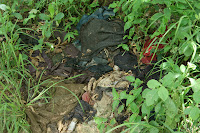We made several stops as we travelled south from Bangkok. The first place stopped was at Prachuap Khiri Khan. Looking out to the bay, it appeared that the rain was following us:
We hired the hotel's only two bicycles at 200THB/day; the same price as hiring a motor scooter and went around the district for the couple of days. We went south on one day





Prachuapkhirikhan was not a very touristy town and a great place to eat seafood. They dried squids along the beach front.
After the seaside town of Surat Thani, while others headed off to the islands and other resorts for some R&R, Le and I decided to travel south on our own and meet up with the group in Penang (Malaysia) about 6 days later.
Like Surat Thani, Krabi is another launching town for tourists to go to west coastal and off-shore resorts. Once again, we were caught in heavy rain while in Krabi. We did manage to visit the Tiger Cave 




Ao Nang when we visited was full of tourists. I hate to see this place in peak tourist season or during better economic times. I was glad we did not plan to stay over there. It was just too crowded for a small town. 
We took a bus to Hat Yai and stayed there for a couple of days and enjoyed the traditional Thai body massage. We wanted to enter Malaysia a couple of days early to avoid the mad season to celebrate the end of Ramadan: all public transport would be booked weeks ahead and most services would be closed, etc. So, we caught the minivan to Penang on Friday 18th Sept, two days before Hari Raya.













































